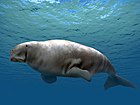Eosiren
(Redirected from Eosiren imenti)
This article's factual accuracy may be compromised due to out-of-date information. (July 2017) |
| Eosiren Temporal range: Late Eocene-Oligocene
| |
|---|---|

| |
| Skull of E. libyca . | |
| Scientific classification | |
| Kingdom: | |
| Phylum: | |
| Class: | |
| Order: | |
| Family: | |
| Subfamily: | |
| Genus: | Eosiren Andrews, 1902
|
| Species | |
| |



Eosiren is an extinct genus of sea cow that lived during the Late Eocene (later Priabonian) to Early Oligocene (Rupelian).[1] Several fossils have been found in Egypt. It seems like the species E. abeli were contemporaneous with Protosiren and Eotheroides.[1] like them, Eosiren closely resembled modern sirenians. It differs from them by having somewhat larger innominates and possess thigh bones.[1]
Eosiren was first described by vertebrage paleontologist Charles William Andrews in 1902, who distinguished it from the genus Halitherium due to differences in the teeth and mandible.[2] Later that year, Science published a summary of his findings in a collection on advances in zoopaleontology.[3]
References[edit]
- ^ a b c Zalmout I.S. & Gingerich P.D. (2012), “Late Eocene sea cows (Mammalia, Sirenia) from Wadi al Hitan in the western desert of Fayum, Egypt”, University of Michigan Papers on Paleontology No. 37
- ^ Andrews, C. W. (1902). "II.—Preliminary Note on some Recently Discovered Extinct Vertebrates from Egypt. (Part III.)". Geological Magazine. 9 (7): 291–295. Bibcode:1902GeoM....9..291A. doi:10.1017/S0016756800181178. S2CID 248538038.
- ^ Osborn, H. F. (31 October 1902). "Recent Zoopaleontology". Science. 16 (409): 749–752. Bibcode:1902Sci....16..749O. doi:10.1126/science.16.410.749. JSTOR 1628916. PMID 17776565. Retrieved 27 January 2021.

